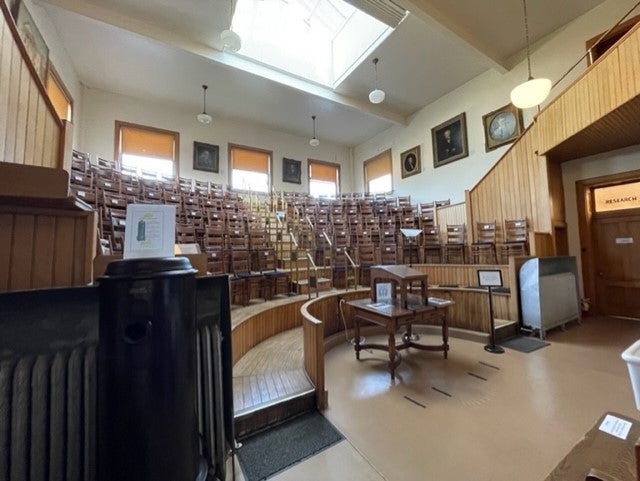Touring Indy’s Treasures: The Indiana Medical History Museum
The Indianapolis area is home to a number of “treasures” — interesting places, museums, and landmarks that make Indy special. Join News 8’s Hanna Mordoh on a tour of Indy’s treasures.
INDIANAPOLIS (WISH) — The Indiana Medical History Museum is located on the grounds of the former Central State Hospital in Indianapolis.
The heart of the museum is the Old Pathology Building. Opened in 1896, it is the oldest surviving pathology facility in the nation and the building is on the National Register of Historic Places.
“The hospital itself opened in 1848 as the Indiana Hospital for the Insane,” Sarah Halter, the Executive Director at the Indiana Medical History Museum, said. “This building opened in 1896 as the pathological department, dedicated to studying physical causes of mental diseases,” Halter said.
In operation until the 1960s, the pathological department was reborn as a museum in 1969, and its scientifically-equipped interior was left intact.
“It really is a time capsule with the original things, these are the original furnishings and equipment that were here in 1896 when the building opened,” Halter added. “When it was built, this was only the second pathology lab in the united states. And, now, it’s the only one of that era that hasn’t been remodeled.”
Inaugurated in 1896, the pathological department facilitated medical education and research on the physical causes of mental disease.
The hospital’s Pathological Department opened in 1896 in order to research the causes and treatments of these diseases.
In operation until the 1960s, the pathological department was reborn as a museum in 1969, and its scientifically equipped interior was left intact.
“I hope (visitors) love it as much as I do. It is a place that is easy to get sucked into,” Halter said.
Halter gave News 8’s Hanna Mordoh a tour of the building.
As you walk into the Indiana Medical History Museum, you’re greeted with antique equipment, historic cameras, test tubes, books, and specimens from more than 100 years ago.

“This is the amphitheater. They did classes for students, students from IU and other medical schools in the city,” said Halter. “They would attend lectures in psychology and neurology. There were also times when mortuary students would come here to learn how to embalm bodies.”
The tour continued into the anatomical museum.
“This is one of the spaces we are most well-known for,” Halter said. “The specimens we have on display here are mostly brains.”
In 2014 the museum started a project to learn more about the specimens. Now their stories are some of the only “updates” visitors will see in the museum and they’re listed next to various parts of human bodies.
“We didn’t want people to leave without understanding that these were real people and they lived real lives — not always happy ones, and, you know, that we can learn a lot from them and their experiences,” Halter said.
Some of those experiences from the past include the labs and library upstairs.
“This room has kind of a ‘mad scientist’ feel that I appreciate. This room is a clinical chemistry lab — this was a clinical lab that supported the hospital,” Halter said.

The laboratory includes a collection of stains. Stains are still used today to help highlight and define tissues, cells, or even the organelles inside cells.
“These stains were used with the histological slides so you would stain the tissue so when you look at it under the microscope you can actually see it,” Halter said.
The next stop on the tour was the library.

“I think just about every room we go into I say this is my favorite room, but the library really is my favorite room because I love all the books,” Halter told News 8.
Throughout its 150-year history, Central State Hospital treated patients with a variety of diagnoses, including schizophrenia (which was earlier diagnosed as dementia praecox), depression (melancholia), general paresis (a problem with mental function due to brain damage caused by untreated syphilis), hysteria, alcoholism, senile dementia (now referred to as dementia or dementia in the elderly) and epilepsy.
At its height around 1950, 2,500 patients were housed at Central State Hospital. With the invention of new medications and the shift toward care in the community, the patient population dwindled in the following decades. After several scandals regarding patient abuse, Central State Hospital closed in 1994.
“We are all affected by mental illness, either directly or indirectly, and while we have come a long way since this building opened, some would argue we have a long way to go,” Halter said. “I think the history that we present here and we preserve and interpret is more relevant today than ever.”
Halter continued: “It is really important to talk about these things, because if we can’t have a conversation about mental illness 100 years ago, how can we talk about the ways it affects us today?”
The old pathology building is open for tours Wednesday through Saturday, by appointment only. Tickets are $10 for adults, $9 for seniors, and $5 for children, while kids under 5 years old get in for free.
Visit the Indiana Medical History Museum website to book a tour or learn more.